The Intel 6th Gen Skylake Review: Core i7-6700K and i5-6600K Tested
by Ian Cutress on August 5, 2015 8:00 AM ESTGenerational Tests on the i7-6700K: Gaming Benchmarks on Mid-Range GPUs
Alien: Isolation
If first person survival mixed with horror is your sort of thing, then Alien: Isolation, based off of the Alien franchise, should be an interesting title. Developed by The Creative Assembly and released in October 2014, Alien: Isolation has won numerous awards from Game Of The Year to several top 10s/25s and Best Horror titles, ratcheting up over a million sales by February 2015. Alien: Isolation uses a custom built engine which includes dynamic sound effects and should be fully multi-core enabled.
For low end graphics, we test at 720p with Ultra settings, whereas for mid and high range graphics we bump this up to 1080p, taking the average frame rate as our marker with a scripted version of the built-in benchmark.
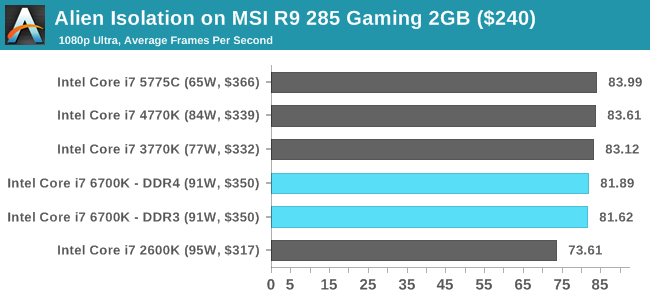
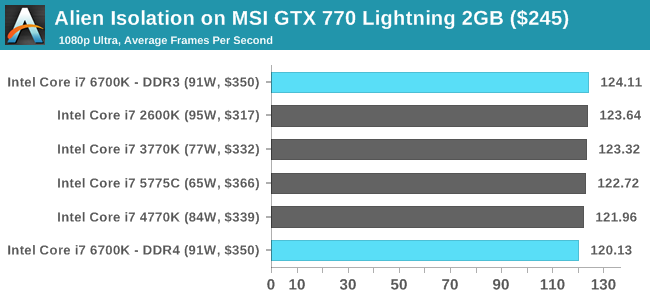
Total War: Attila
The Total War franchise moves on to Attila, another The Creative Assembly development, and is a stand-alone strategy title set in 395AD where the main story line lets the gamer take control of the leader of the Huns in order to conquer parts of the world. Graphically the game can render hundreds/thousands of units on screen at once, all with their individual actions and can put some of the big cards to task.
For low end graphics, we test at 720p with performance settings, recording the average frame rate. With mid and high range graphics, we test at 1080p with the quality setting. In both circumstances, unlimited video memory is enabled and the in-game scripted benchmark is used.
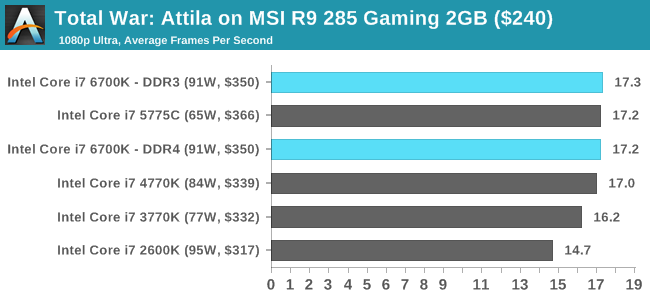
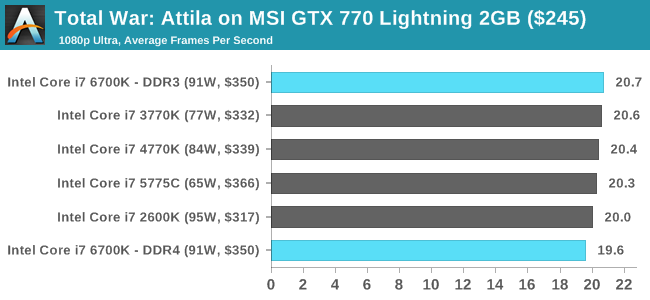
Grand Theft Auto V
The highly anticipated iteration of the Grand Theft Auto franchise finally hit the shelves on April 14th 2015, with both AMD and NVIDIA in tow to help optimize the title. GTA doesn’t provide graphical presets, but opens up the options to users and extends the boundaries by pushing even the hardest systems to the limit using Rockstar’s Advanced Game Engine. Whether the user is flying high in the mountains with long draw distances or dealing with assorted trash in the city, when cranked up to maximum it creates stunning visuals but hard work for both the CPU and the GPU.
For our test we have scripted a version of the in-game benchmark, relying only on the final part which combines a flight scene along with an in-city drive-by followed by a tanker explosion. For low end systems we test at 720p on the lowest settings, whereas mid and high end graphics play at 1080p with very high settings across the board. We record both the average frame rate and the percentage of frames under 60 FPS (16.6ms).
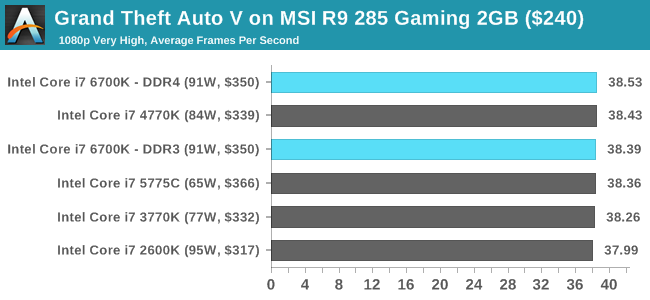
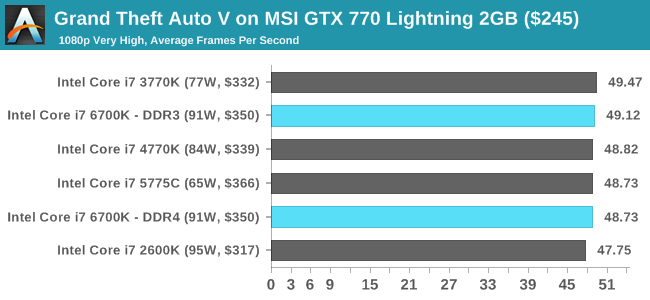
GRID: Autosport
No graphics tests are complete without some input from Codemasters and the EGO engine, which means for this round of testing we point towards GRID: Autosport, the next iteration in the GRID and racing genre. As with our previous racing testing, each update to the engine aims to add in effects, reflections, detail and realism, with Codemasters making ‘authenticity’ a main focal point for this version.
GRID’s benchmark mode is very flexible, and as a result we created a test race using a shortened version of the Red Bull Ring with twelve cars doing two laps. The car is focus starts last and is quite fast, but usually finishes second or third. For low end graphics we test at 1080p medium settings, whereas mid and high end graphics get the full 1080p maximum. Both the average and minimum frame rates are recorded.
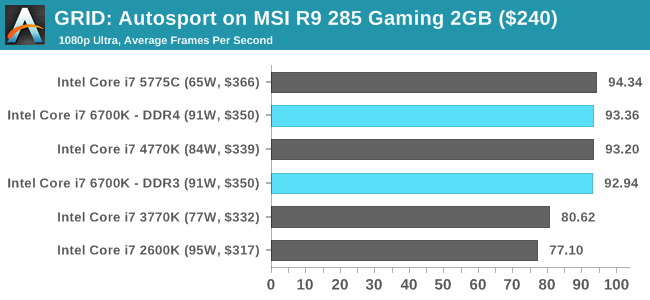
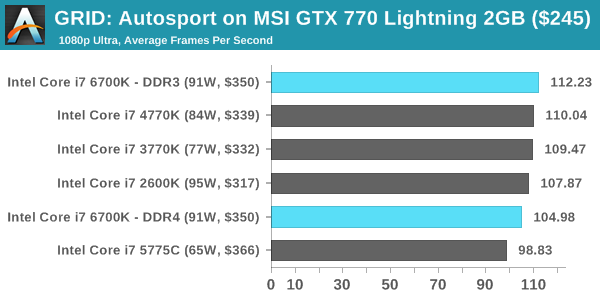
Middle-Earth: Shadow of Mordor
The final title in our testing is another battle of system performance with the open world action-adventure title, Shadow of Mordor. Produced by Monolith using the LithTech Jupiter EX engine and numerous detail add-ons, SoM goes for detail and complexity to a large extent, despite having to be cut down from the original plans. The main story itself was written by the same writer as Red Dead Redemption, and it received Zero Punctuation’s Game of The Year in 2014.
For testing purposes, SoM gives a dynamic screen resolution setting, allowing us to render at high resolutions that are then scaled down to the monitor. As a result, we get several tests using the in-game benchmark. For low end graphics we examine at 720p with low settings, whereas mid and high end graphics get 1080p Ultra. The top graphics test is also redone at 3840x2160, also with Ultra settings, and we also test two cards at 4K where possible.
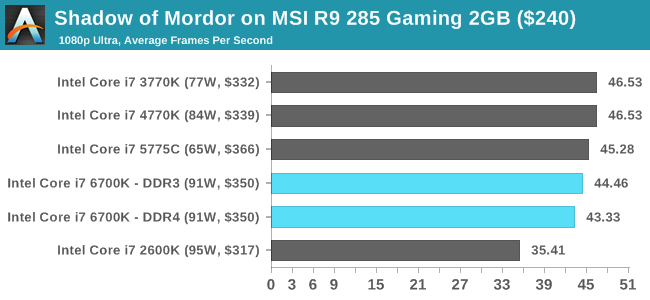
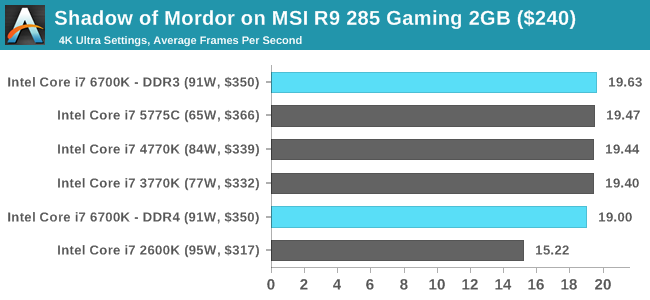

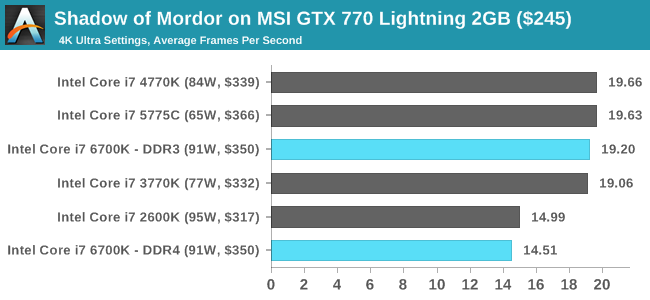















477 Comments
View All Comments
jwcalla - Wednesday, August 5, 2015 - link
I kind of agree. I think I'm done with paying for a GPU I'm never going to use.jardows2 - Wednesday, August 5, 2015 - link
If you don't overclock, buy a Xeon E3. i7 performance at i5 price, without integrated GPU.freeskier93 - Wednesday, August 5, 2015 - link
Except the GPU is still there, it's just disabled. So yes, the E3 is a great CPU for the price (I have one) but you're still paying for the GPU because the silicon is still there, you're just not paying as much.MrSpadge - Wednesday, August 5, 2015 - link
Dude, an Intel CPU does not get cheaper if it's cheaper to produce. Their prices are only weakly linked to the production costs.AnnonymousCoward - Saturday, August 8, 2015 - link
That is such a good point. The iGPU might cost Intel something like $1.Vlad_Da_Great - Wednesday, August 5, 2015 - link
Haha, nobody cares abot you @jjj. Integrating GPU with CPU saves money not to mention space and energy. Instead of paying $200 for the CPU and buy dGPU for another 200-300, you get them both on the same die. OEM's love that. If you dont want to use them just disable the GPU and buy 200W from AMD/NVDA. And it appears now the System memory will come on the CPU silicon as well. INTC wants to exterminate everything, even the cockroaches in your crib.Flunk - Wednesday, August 5, 2015 - link
Your generational tests look like they could have come from different chips in the same series. Intel isn't giving us much reason to want to upgrade. They could have at least put out a 8-core consumer chip. It isn't even that much more die space to do so.BrokenCrayons - Wednesday, August 5, 2015 - link
With Skylake's Camera Pipeline, I should be able to apply a sepia filter to my selfies faster than ever before while saving precious electricity that will let me purchase a little more black eyeliner and those skull print leg warmers I've always wanted. Of course, if it doesn't, I'm going to be really upset with them and refuse to run anything more modern than a 1Giga-Pro VIA C3 at 650 MHz because it's the only CPU on the market that is gothic enough pending the lack of much needed sepia support in Skylake.name99 - Wednesday, August 5, 2015 - link
And BrokenCrayons wins the Daredevil award for most substantial of lack vision regarding how computers can be used in the future.For augmented reality to become a thing we need to, you know, actually be able to AUGMENT the image coming in through the camera...
Today on the desktop (where it can be used to prototype algorithms, and for Surface type devices). Tomorrow in Atom, and (Intel hopes), giving them some sort of edge over ARM (though good luck with that --- I expect by the time this actually hits Atom, every major ARM vendor will have something comparable but superior).
Beyond things like AR, Apple TODAY uses CoreImage in a variety of places to handle their UI (eg the Blur and Vibrancy effects in Yosemite). I expect they will be very happy to use new GPU extensions that do this with lower power, and that same lower power will extend to all users of the CI APIs.
Without knowing EXACTLY what Camera Pipeline is providing, we're in no position to judge.
BrokenCrayons - Friday, August 7, 2015 - link
I was joking.